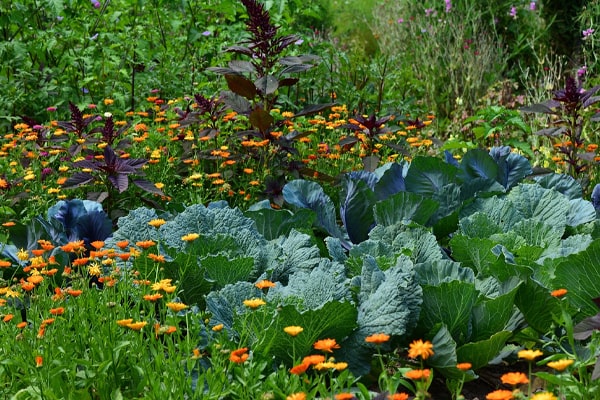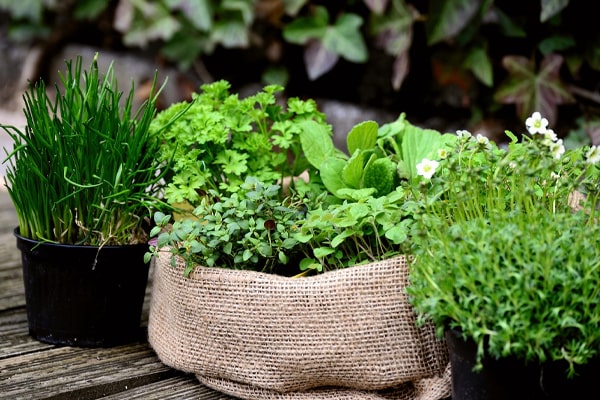Did you know that some plants grow better together when planted near each other? This technique is called companion planting and it can help you maximize your garden to the fullest!
Using raised beds in companion planting is more ideal than growing plants together in a traditional row garden. In this blog, learn which plants work well together and which ones don’t in a raised bed.
Contents []
Using Companion Planting to Grow a Healthy Garden
Companion Planting Recommendations
Using Companion Planting to Grow a Healthy Garden
Companion planting is not new; it’s been used by farmers for thousands of years to increase their yield and maintain a healthy garden. When compatible plants are grown together, they form a symbiotic relationship, complementing each other’s attributes. And these attributes are often amplified. One plant may stave off pests while the other boosts growth. Some plants could also improve each other’s flavor and fruitfulness.
Of course, some plants do not grow well together, and that’s what you need to figure out to avoid a disaster! Want to give companion planting a try? Here are some of the benefits of companion planting:

Benefits of Companion Planting
Protection from the Elements: Some plants are delicate, and planting hardy plants near them helps protect them from the sun, wind, and rains.
Improve Pollination: Plants grown side by side with big blooms or powerful scent attracts pollinators. When more pollinators are in the area, the plants nearby will bear more fruits.
Repelling Pests: Some plants repel pests, and growing them near complementing crops helps keep common pests away. Some plants could also lure and trap pests, protecting vegetables and fruit-bearing plants from being destroyed by nibbling, burrowing pests.
Better Soil Health: Some plants either bring nutrients back into the soil or acquire nitrogen from the air, so the plants nearby stay healthy.
Importance of Companion Planting for Raised Beds
Companion planting can be applied to inground plants as well as plants grown in raised garden beds. When implementing companion planting for raised beds, expect the following benefits:
Better Pest Control

Plants grown in raised beds need protection from pests too. And companion planting keeps most pests away without using toxic chemicals found in insecticides. Some plants can suppress the growth of harmful organisms, while other plants have a foul scent or taste that pests find disgusting, so they'll stay away! Some of these plants are:
- Garlic
- Onions
- Asparagus
- Cilantro
- Radishes
- Basil
- Asparagus
As long as these plants are grown side by side complementing plants, it is possible to raise crops organically. As long as these plants are grown side by side complementing plants, it is possible to raise crops organically.
Better Flavor

Does growing certain plants near specific crops improve their flavor? You bet. Companion planting is often applied to growing herbs because certain plants enhance the taste of the herbs.
- Borage
- Thyme
- Basil
- Chamomile
- Chervil
When grown side by side complementing plants, these plants could deepen their flavor or enhance their flavor. For example, thyme or borage is often planted near strawberries to help the latter bear sweeter fruits. Cilantro and basil are grown side by side with tomatoes to enhance each other's flavors. Chervil, when planted near radishes, makes the radishes spicier.
Better Soil Health

That's right; some plants improve the health of the soil. Some plants add nitrogen to the earth by pulling them from the air. Others bring calcium and other minerals into the soil.
- Clover
- Peas
- Beans
Different types of clover, peas, and beans are best-grown side-by-side plants that need nitrogen or calcium. These plants are best grown alongside plants that heavily feed on nitrogen or calcium.
Provides Shelter
Combining low-lying crops with climbing, tall, or vining plants will protect the vulnerable crops from pests and the elements. For example, lettuces and peas are often grown together because lettuce warms the soil for the peas while the peas give much-needed shade to the lettuce during the summer season.
What plants (or vegetables) should be planted together in a raised bed?
Beans and Corn: Corn is tall, so it gives shade to the beans. Beans add nitrogen into the soil, a nutrient that corn loves.
Marigolds and Nasturtiums: Both plants can repel pests. Marigolds could repel Mexican bean beetles while nasturtiums repel whiteflies, cabbage pests, and squash bugs. It also attracts pollinators like hummingbirds and butterflies with its blooms.
Basil and Tomatoes: Basil improves the flavor of the tomatoes while repelling climbing and nibbling pests like aphids.
Borage and Squash: Borage helps improve the flavor of fruit-bearing crops and repels burrowing pests like worms. It’s also ideal for planting borage alongside strawberries and tomatoes!
Cosmos Flowers and Vegetables: If you have a raised vegetable garden, be sure to plant cosmos flowers nearby! The cosmos flowers will deter predatory insects and crawling pests such as ladybugs.
What plants (or vegetables) should not be planted together? (combinations to avoid)
Some plants do not grow well together. Competing plants may dominate fragile crops for soil nutrients or stifle their roots and dilute their flavors. Never plant alliums like garlic near beans and peas. Carrots shouldn’t be grown near dill and other members of this family. Fragrant herbs shouldn’t be grown side by side with cucumbers.
Companion Planting Recommendations
Tomatoes with Basil and Garlic: This combination repels pests while enhancing the crops’ flavor.
Radish with Cabbage and Marigolds: Controls pests like grubs and slugs that nibble at the plant roots or leaves.
Lettuce with Chives and Carrots: Lettuce repels rust flies while chives deter aphids and flea beetles.
Squash with Runner Beans and Corn: AKA the “Three Sisters,” corn and beans deter pests while squash speeds up fruit-bearing. Corn acts as a natural trellis for vining beans.
Companion planting is a wonderful concept for gardening because it repels pests, enhances flavors, and increases your crops’ yield -- all without using chemicals! With these tips, you can finally try companion planting and find out for yourself why many gardeners rave about this technique.



